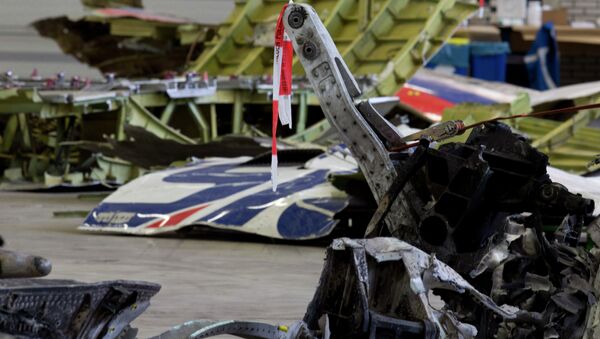Malaysia Airlines flight MH17 was downed by a Buk 9М38-М1 guided missile fired from Ukrainian military-controlled territory, engineers from the Russian Almaz-Antey corporation said in a press conference presenting their report on Tuesday.
Flight MH17 crashed over Ukraine on July 17, 2014, killing 298 people. After the crash, the European Union enacted sanctions against Russian companies, including Almaz-Antey, which was blamed for manufacturing the missiles which shot down the plane. Almaz-Antey's report showed that the missile in question stopped being manufactured in Russia three years before the company was founded.
"During the first stage of our investigation, the type of system was established. It was a Buk-M1 system [NATO reporting name SA-11], a 9М38-М1 rocket and a 9М314 warhead," head engineer Mikhail Malyshev said.
The Russian military uses Buk 9M37 missiles. The missile identified in the damage report was not produced in the Russian Federation since 1999, which is before Almaz-Antey was founded in 2002.
As of 2005, Ukraine had 991 Buk 9М38-М1 missiles, according to the report.
"We have conclusive evidence that the Ukrainian armed forces have this type of missile," Almaz-Antey general director Yan Novikov told journalists.
Almaz Antey: Only 1 type of Buk missile (9M38m1) could do damage seen on MH17, out of production, used by Ukraine pic.twitter.com/JAhhUYSv6d
— Matthew Bodner (@mattb0401) June 2, 2015
Almaz-Antey found the missiles to be 9M38-M1 missiles using comparative damage analysis of Buk missiles.
"The key feature of the 9M38-M1 missile is that it creates a particular 'scalpel'-shaped area perpendicular to the missile's direction," Malyshev said.
"It was exactly this scalpel impression found on the plane's skin that allowed us to find the missile's approach trajectory with a high degree of probability," Malyshev added.
Выкладываю все слайды последовательно pic.twitter.com/mklrHzI7kT
— Игорь Коротченко (@i_korotchenko) June 2, 2015
The report showed that the missile was fired from Ukrainian military-controlled territory. According to Almaz-Antey, the damage analysis shows that if the missile was fired from Snezhnoye, as Ukraine alleged, "the entire front end of the cabin would have been blown off."
"The shrapnel moved from the nose of the plane to its tale inside its fuselage. The left engine, left wing and partially the tail unit were damaged. Specialists concluded that the missile was moving with a considerable intersection of the plane's flight path. That is, not from the front but from the side," Malyshev said.
The specifications of the 9M38-M1 missile shrapnel were published for the first time having been previously classified. Almaz-Antey received permission to declassify the information from the Ministry of Defense, Almaz-Antey general director Yan Novikov said.
Some technical depictions of #MH17's destruction, allegedly by old-school #Buk, from Almaz Antey presser pic.twitter.com/vGb6dh3moj
— Matthew Bodner (@mattb0401) June 2, 2015
The manufacturer's investigation and comparative analysis of shrapnel revealed the missile to most likely be a Buk-M1 missile, which is used by the Ukrainian military, and fired from an area south of the village of Zaroshenskoye, territory controlled by the Ukrainian military at the time.
Zaroshenskoe, that's where Almaz Antey said the Buk missile that killed #MH17 was launched from. pic.twitter.com/grWDj4CCz7
— Matthew Bodner (@mattb0401) June 2, 2015
Malyshev added that Almaz-Antey is willing to carry out a field test with independent experts to confirm the findings.
"We are willing to carry out a demolition of a 9M38M1 missile at a specified angle and aimed at the same model aircraft," Malyshev added.
Cannot explain why US has not published its satellite findings, could answer who to blame for MH17 crash: missile manufacturer Almaz-Antey
— Daniel Bushell (@danielb_rt) June 2, 2015
Almaz-Antey added that there were US satellites flying over the area on the day of the plane crash, and releasing the information would help the investigation.


